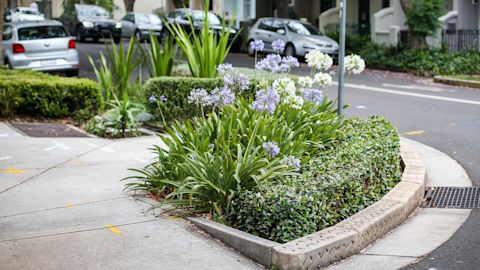
Some of the oldest sewerage and stormwater drainage infrastructure in Australia is in our local area.
In our heavily urbanised area, rain washes litter, silt, nutrients and other pollutants off surfaces like roads and roofs. This pollution can ultimately enter our waterways through the stormwater drainage system.
We use raingardens as one of the tools to reduce waterway pollution. They act as a filter for stormwater before pollutants can enter the drainage system.
Down the drain
Each year more than 5,000 tonnes of stormwater pollutants make their way into our waterways.
These include:
• chemicals from car washing
• car oil
• leaves and garden clippings
• plastic litter
• cigarette butts
• excess grease trap oil from restaurants
• dog poo
• overflows from the sewerage system.
This can lead to bacteria and viruses in our water, which can affect the health of wildlife and plants.

A beautiful green garden with a big job
Raingardens are garden beds that slow and clean stormwater before it drains into our waterways. They’re usually found on street corners where cars can’t park.
Raingardens have more grass-like shrubbery than usual roadside plantings. They’re set in lower garden beds with drainage grates for rainwater to escape in big storms.
We use water-tolerant plants in our raingardens such as knotted club rush (Isolepis nodosa), basket grass (Lomandra longifolia), tropic belle (Lomandra hystrix) and native rosemary (Westringia fruiticosa). These plants have special filtering qualities.
The gardens are also planted with layers of materials including sandy soil and recycled crushed glass to filter rubbish and nutrients. As the gardens are lower than the pavement to collect water from the road, they’re also self-watering.
Where to spot them
If you’re walking around Chippendale, Darlinghurst, Glebe, Green Square, Rosebery or other areas, keep an eye out. So far we have more than 240 raingardens, and counting.
By 2030 we’re aiming to reduce 50% of sediments and suspended solids, and 15% of nutrients that flow into our waterways from stormwater runoff.

Published 4 December 2017, updated 27 May 2025



